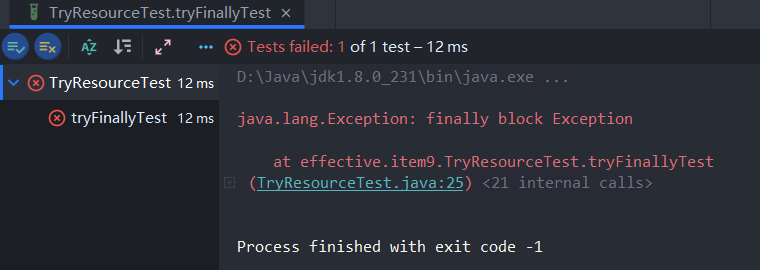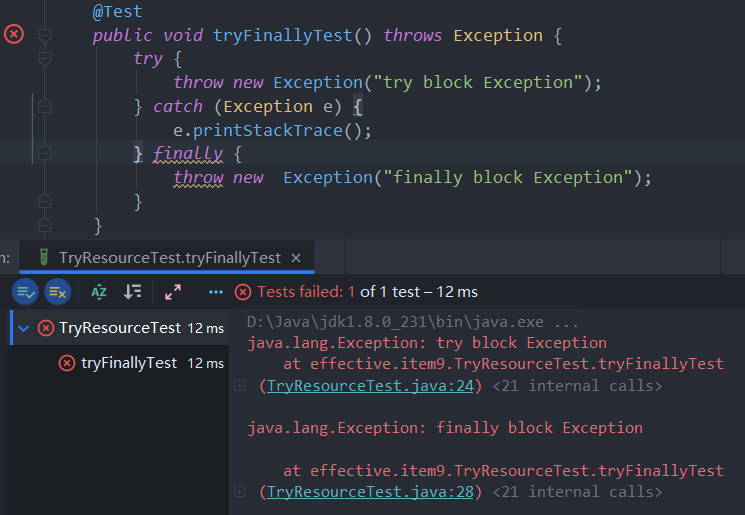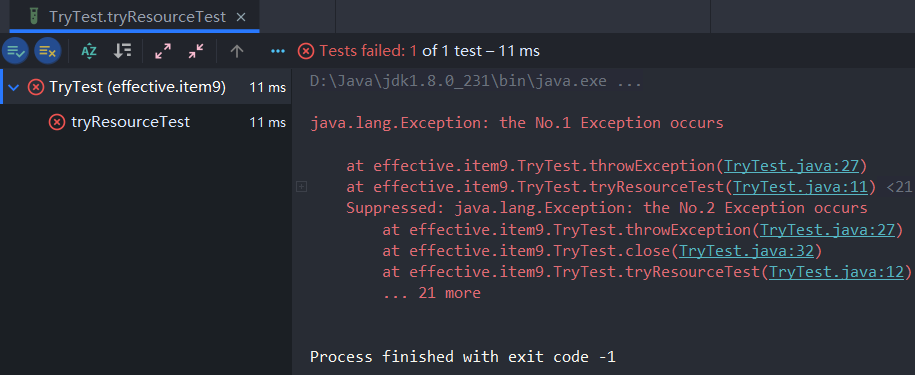Effective Java —— try-with-resources 优先于 try-finally
本文参考
本篇文章参考自《Effective Java》第三版第九条"Prefer try-with-resources to try-finally"
The code in both the try block and the finally block is capable of throwing exceptions.The second exception(in finally block) can completely obliterate the first one
try块和finally块都有可能抛出异常,若同时抛出异常,则finally块中的第二个异常将会覆盖try块的异常,使我们无法追踪到程序错误的根源,例如下面这段代码示例
@Test
public void tryFinallyTest() throws Exception {
try {
throw new Exception("try block Exception");
} finally {
throw new Exception("finally block Exception");
}
}
从执行结果中可以看出,try块中的异常没有显示

下面是一个更加实际的例子,BufferReader的readLine()方法和close()方法都会抛出IoException异常,close()抛出的异常可能会覆盖readLine()方法的异常
public void tryFinallyTest(String path) throws IOException {
BufferedReader reader = new BufferedReader(new FileReader(path));
try {
System.out.println(reader.readLine());
} finally {
reader.close();
}
}
我们可以通过catch块捕获try块内的异常,这样finally块的异常就不会覆盖try块的异常

但是这未免有点"奇怪",因为当我们为方法加上throws Exception时,希望方法内产生的异常交由调用方或更上一级去处理,而不是在方法内部处理
这样一来,try块的异常由方法内部处理,而finally块的异常由调用方或更上一级处理,增加了我们对异常捕获的管理难度
Not only are the try-with-resources versions shorter and more readable than the originals, but they provide far better diagnostics
自java7开始加入了try-with-resource语法并引入了AutoCloseable接口,只要相关资源的类或接口实现或继承了这个接口,就可以不显式调用close()方法,自动关闭资源,并且不会有上述"异常覆盖"的情况发生
An object that may hold resources (such as file or socket handles) until it is closed. The close() method of an AutoCloseable object is called automatically when exiting a try-with-resources block for which the object has been declared in the resource specification header. This construction ensures prompt release, avoiding resource exhaustion exceptions and errors that may otherwise occur.
我们同时用两种形式的try语句来进行测试,throwException()方法累计抛出的异常
public class TryTest implements AutoCloseable {
private int count = 0;
@Test
public void tryResourceTest() throws Exception {
try(TryTest test = new TryTest()) {
test.throwException();
}
}
@Test
public void tryFinallyTest() throws Exception {
TryTest test = new TryTest();
try {
test.throwException();
} finally {
test.close();
}
}
public void throwException() throws Exception {
count++;
throw new Exception("the No." + count + " Exception occurs");
}
@Override
public void close() throws Exception {
throwException();
}
}
try-finally语句块的执行结果

try-with-resources语句块的执行结果

我们可以成功看到我们真正想要看到的第一个异常信息,第二个异常被标注为抑制
In fact, multiple exceptions may be suppressed in order to preserve the exception that you actually want to see. These suppressed exceptions are not merely discarded; they are printed in the stack trace with a notation saying that they were suppressed. You can also access them programmatically with the getSuppressed method, which was added to Throwable in Java 7
在try-with-resources语句块我们还是能够使用catch语句和finally语句,下面是一个更加实际的例子:
public void copy(String src, String dst) {
try (InputStream in = new FileInputStream(src); OutputStream out = new FileOutputStream(dst)) {
byte[] buf = new byte[BUFFER_SIZE];
int n;
while ((n = in.read(buf)) >= 0) out.write(buf, 0, n);
} catch (IOException e) {
e.printStackTrace();
}
}
因此在处理必须关闭的资源时,我们始终要优先考虑用 try-with-resources,而不是用try-finally,这样得到的代码将更加简洁、清晰,产生的异常也更有价值
Effective Java —— try-with-resources 优先于 try-finally的更多相关文章
- [Effective Java]第八章 通用程序设计
声明:原创作品,转载时请注明文章来自SAP师太技术博客( 博/客/园www.cnblogs.com):www.cnblogs.com/jiangzhengjun,并以超链接形式标明文章原始出处,否则将 ...
- EFFECTIVE JAVA 第十一章 系列化
EFFECTIVE JAVA 第十一章 系列化(将一个对象编码成一个字节流) 74.谨慎地实现Serializable接口 *实现Serializable接口付出的代价就是大大降低了“改变这个类 ...
- Effective Java通俗理解(下)
Effective Java通俗理解(上) 第31条:用实例域代替序数 枚举类型有一个ordinal方法,它范围该常量的序数从0开始,不建议使用这个方法,因为这不能很好地对枚举进行维护,正确应该是利用 ...
- 《Effective Java(中文第二版)》【PDF】下载
<Effective Java(中文第二版)>[PDF]下载链接: https://u253469.pipipan.com/fs/253469-230382186 Java(中文第二版)& ...
- 《Effective Java》 学习笔记 —— 并发
<Effective Java>第二版学习笔记之并发编程. 第66条 同步访问共享的可变数据 * 关键字synchronized可以保证在同一时刻只有一个线程可以执行某个方法或代码块. * ...
- [Java读书笔记] Effective Java(Third Edition) 第2章 创建和销毁对象
第 1 条:用静态工厂方法代替构造器 对于类而言,获取一个实例的方法,传统是提供一个共有的构造器. 类可以提供一个公有静态工厂方法(static factory method), 它只是一个返回类 ...
- 《Effective Java》笔记45-56:通用程序设计
将局部变量的作用域最小化,可以增强代码的可读性和可维护性,并降低出错的可能性. 要使用局部变量的作用域最小化,最有力的方法就是在第一次使用它的地方才声明,不要过早的声明. 局部变量的作用域从它被声明的 ...
- effective java 学习心得
目的 记录一下最主要学习心得,不然凭我这种辣鸡记忆力分分钟就忘记白看了... 用静态工厂方法代替构造器的最主要好处 1.不必每次都创建新的对象 Boolean.valueOf Long.valueOf ...
- effective java 读后感
think in java , effective java 这两本书一直都在java的生态圈中经久不衰.本来想着先翻过 think in java 这本大山,但是读到一半就放弃了.过长的篇幅,让 ...
随机推荐
- 第一次接触数据库(SQLite)
第一次接触,学了创建列表 + 行的删除 + 内容的更改 + 删除列表 第一次接触要知道一些基本知识 NULL(SQL) = Nnoe(python) #空值 INTEGER = int #整数 R ...
- 【C# Task】 ValueTask/Task<TResult>
概要 1.如果异步方法的使用者使用 Task.WhenAll 或 Task.WhenAny,则在异步方法中使用 ValueTask<T> 作为返回类型可能会产生高昂的成本.这是因为您需要使 ...
- 【windwos 操作系统】关键的Windows内核数据结构一览(下)
I/O管理器 nt!_IRP IRP表示一个I/O请求包结构体,它用来封装执行一个特定I/O操作所需要的所有参数以及I/O操作的状态.IRP的表现也类似于一个线程独立调用栈因此它可以从一个线程传递到另 ...
- Oracle 数据库用户锁定与解锁,用户锁定最大密码失败次数设置方法,ORA-28000: the account is locked问题解决方法
转至:https://blog.csdn.net/qq_38161040/article/details/108274161 用户多次密码输入错误达到一定值就会被锁定. -- 用户锁定方法 alter ...
- Linux CentOS7.X-文件操作命令
一.文件新增,touch 1.touch fileName,其中fileName表示文件名称,代表创建一个空文件: 2.touch fn1 fn2 fn3....fnn,其中fn1至fnn表示n个不同 ...
- 2022年官网下安装RabbitMQ最全版与官网查阅方法
目录 一.Erlang环境部署 1.百度搜索"Erlang",或者访问网址:https://www.erlang.org/,找到DOWNLOAD双击进入. 2.找到支持的windo ...
- Python 从底层结构聊 Beautiful Soup 4(内置豆瓣最新电影排行榜爬取案例)
1. 前言 什么是 Beautiful Soup 4 ? Beautiful Soup 4(简称 BS4,后面的 4 表示最新版本)是一个 Python 第三方库,具有解析 HTML 页面的功能,爬虫 ...
- Python文件读写--错误一
在学习python的文件读写操作的时候,我遇到了一点麻烦事,觉得可以记录下来,先上代码吧. with open('test.txt') as file: file.write('test') prin ...
- pandas常用操作详解——数据运算(一)
表与表之间的数据运算 #构建数据集df1=pd.DataFrame(np.random.random(32).reshape(8,4),columns=list('ABCD')) df2=pd.Dat ...
- quartz框架(十)-QuartzShedulerThread
QuartzSchedulerThread 本篇博文,博主将介绍QuartzSchedulerThread的相关内容.话不多说,直接进入正题. 什么是QuartzSchedulerThread? 从源 ...
